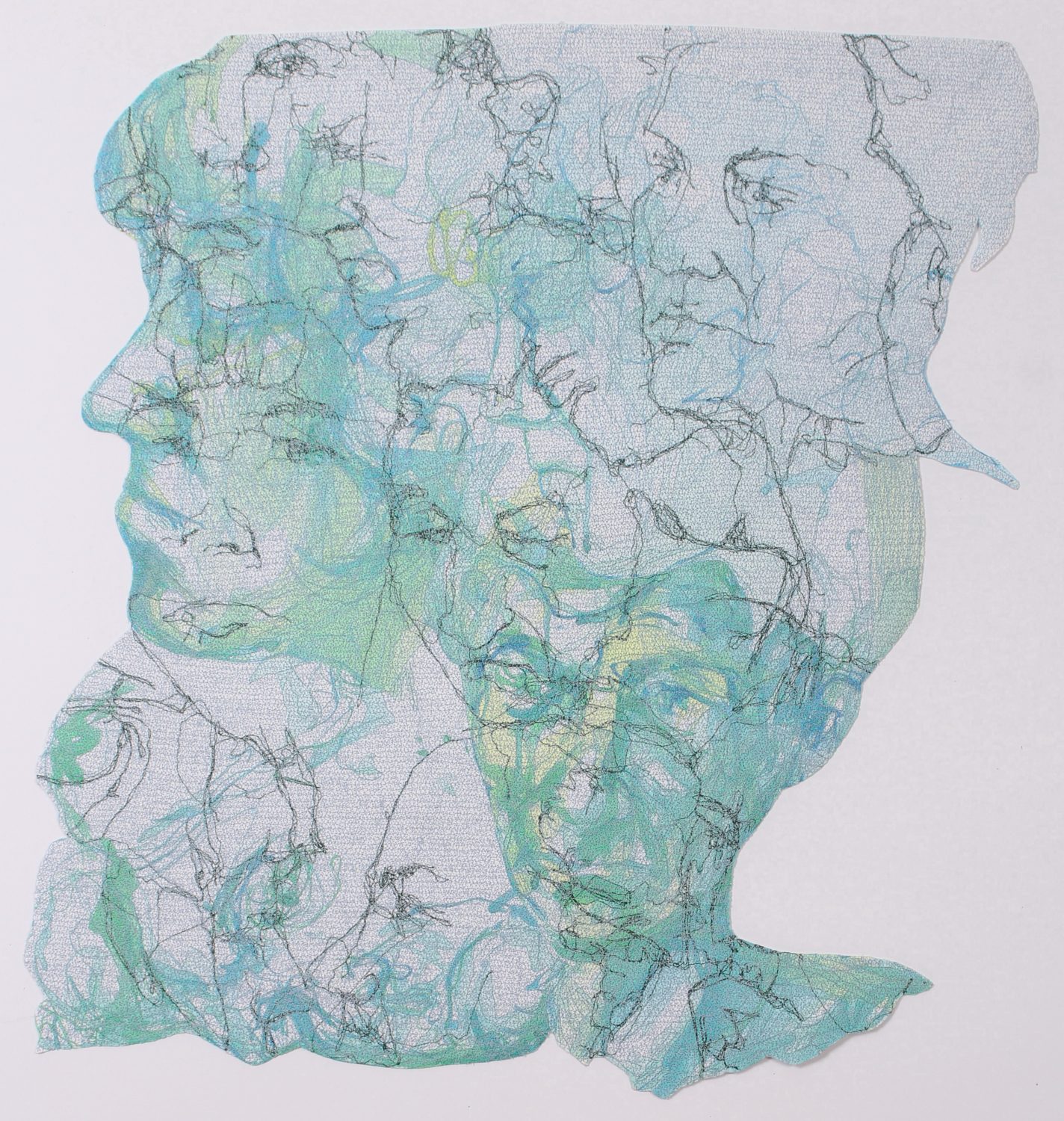
At Mr X Stitch we love to review textile art and embroidery books for you. There are so many great books to discover, packed with needlework inspiration and textile techniques, so we dive into each book to find out what’s good, what’s bad and let you know why you should pick it up.
Here’s what we think of Foolproof Flower Embroidery: 80 stitches and 400 combinations in a variety of fibers… written by Jennifer Clouston, published by C&T PUBLISHING
Stitch your very own garden with step-by-step illustrated instructions for over 80 embroidery stitches and 400 stitch combinations! Explore your stitching versatility with this comprehensive guide by learning to use any thread and embroidery stitch you desire! From textured stems and leaves to colourful bunches of flowers – your end result will look and feel like a true artistic and organic garden.
About the author
Jennifer is a textile artist, third-time author (‘Foolproof Crazy Quilting’ and ‘Foolproof Crazy-Quilt’) and sought-after tutor. Her trademark is crazy quilting with a modern and playful take on traditional embroidery, designing new and original stitches. Her goal is to encourage fellow stitchers and quilters to take risks, be playful and explore their own individuality. Visit Jennifer Clouston for classes and links to her social media accounts.

Who is this book aimed at?
Jennifer encourages readers to ”Play! I dare you!…Start where you are and use what you have”, experiment and do not follow established patterns to uncover a rich, organic approach for unique creativity. Beginners and seasoned embroiderers can access this huge catalogue of stitches and threads to create ”all things floral; stems, leaves, petals, centres, and interesting twig effects” to produce both traditional sampler embroideries and embellishment of textiles. A rich and detailed vocabulary for anyone starting or wanting to develop a more varied foundation of stitch.
Content
This book is so detailed and well laid out with a useful ‘how to use this book’ guide and information on tools, threads and embellishments for texture (buttons, beads, sequins, lace, yarn). The ‘creating backgrounds’ section really encourages the reader to recycle – using vintage fabrics, crazy-quilt blocks, ‘boro’ work (scraps of cloth), snippet collages (tiny pieces of lace and fabric), fabric collages, patchwork blocks, using repurposed clothing and mixed textile weaving.

The embroidery stitch guide is broken down into chapters on theme (stems, leaves, petals and flowers, flower centres and calyxes and buds, twigs) with each flower combination (stem, leaf, flower etc) referenced as a block A-Z with thread detail and a page reference to very clear diagrams for each stitch. This system of information makes intricate stitches easy to follow for beginners and an encyclopedia for all.

Here is an example of each theme. See how many stitches you recognise.
Stems – hold up the flower heads but should not dominate the design. Stitch and colour is determined by background choice. Stitches include rope, feather (straight, twig, Spanish knotted), fern, Palestrina knot, back, straight, couching, beaded (fly, back, feather), knotted stem (Portugese, Spanish), stem (thin, alternating, beaded), coral, chain (uneven, ribbon, feathered, twisted, single twisted), fly, thorn, wheatear.
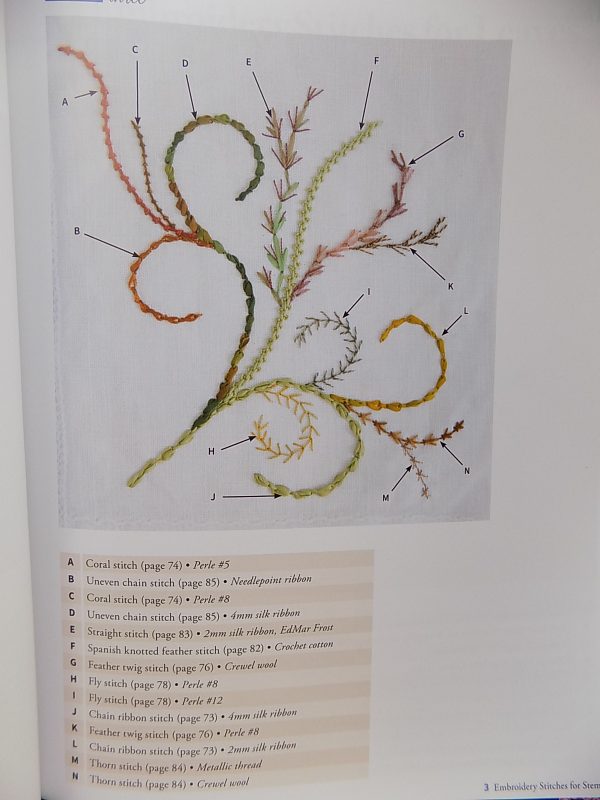
Leaves – With such a variety on offer be inspired to experiment with mixing threads for colour and texture. Stitches include fishbone (staggered, uneven edge, with beads, open, back, straight, single twisted chain) fly (single bead, beaded, stem, single twisted chain), blanket (up-and-down, stem), lazy daisy (knotted, bullion, colonial knot, stem), twisted lazy chain and lazy daisy (stem, chain, straight, bullion, couching, back, beaded, single bead, extended), dimensional (woven bar, drizzle, woven picot, Palestrina knot), detached blanket (twisted chain).

Petals and Flowers – Petals make the flower beautiful, attracting bees and insects to pollinate the plant. Choose glorious colours and interesting shapes, making them bold in scale. Stitches include colonial knot, straight, single bead, stem, ribbon, lazy daisy and twisted chain (detached twisted chain, colonial knot, couching, single bead, straight, knotted lazy daisy, back, twisted lazy daisy, stem).

Rose Petals – Techniques include bullion, upright, ruched and spiderweb rose. Stitches include knot (bullion, colonial, ghiordes, untrimmed), fishbone, straight, blanket (detached), cast-on (looped), lazy daisy (twisted, bullion), stem, feather (Spanish knotted), single bead, free-form flower with beaded centre, beaded (rose, leaf), ribbon.
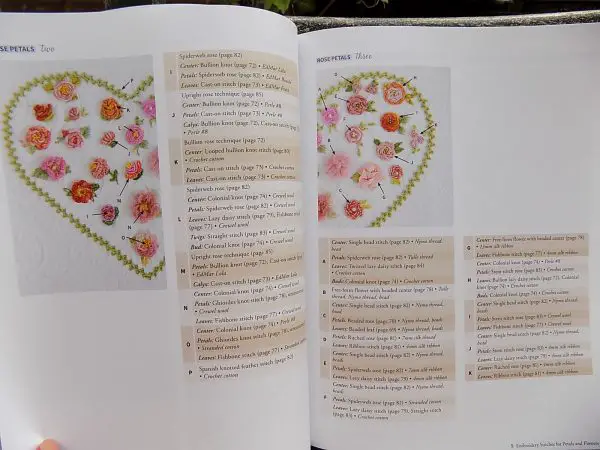
Ghiordes, Knots, Loops and Tufts – stitches include tufting, ghiordes stitch and knot (trimmed and untrimmed), detached loop, grab, straight, chain (uneven, twisted), stem, back, couching, detached blanket, Portugese knotted stem, straight, lazy daisy, back, whipping, colonial, Palestrina knot, fern.

Colonial and French Knot Flowers make up a plethora of flower heads. Stitches include ribbon, grab, straight, stem, fly, lazy daisy (twisted), feather, couching, ghiordes knot, back, whipping, fishbone.
Buttonhole Stitch Flowers – stitches include beaded couched sequin, blanket (detached), straight, bullion lazy daisy, colonial knot, chain (uneven, twisted), feather twig, stem (thin), fishbone, ribbon, single bead.
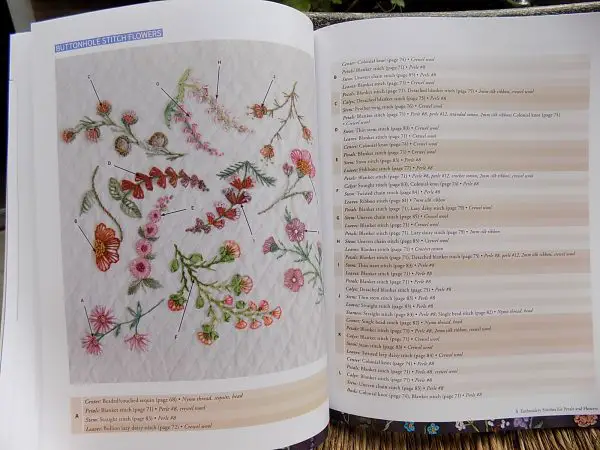
Bullion Knot Flowers – stitches include knots (bullion, looped, colonial, French, Palestrina), chain (feathered, twisted), bead (single), rope, stem, fly, fishbone, tufting, twisted lazy daisy, couching, straight.

Cast-on Stitch Flowers – stitches include cast-on (looped), straight, lazy daisy (bullion), stem, fern, tufting, knot (colonial, Palestrina), fly, single bead, fishbone, feather twig.
Flower Centres – vital to the overall appearance of the embroidery so make them large enough to accommodate the many petals that will surround them. Techniques include bullion rose knot, ruched rose and spiderweb rose. Stitches include beaded/ couched sequin, straight, knot (colonial, ghiordes), cast-on, woven spiderweb, drizzle, buttons and beads (single bead, rose, tassel, forget-me-knot, free-form flower with beaded centre).
Calyxes – hold the petals in place. Stitches include cast-on, straight, knot (bullion, colonial), ribbon, woven spiderweb, lazy daisy.
Buds – should not overpower the main flowers within the design. Stitches include straight, cast-on (looped), woven picot, knot (bullion, looped, colonial, French), drizzle, ribbon (loop), lazy daisy (bullion), fly, single bead, couching, tufting, beaded leaf, grab.

Twigs – add movement and dimension. Keep them fine and delicate. Stitches include straight, knot (French, colonial), stem, lazy daisy (extended, twisted), couching, chain (twisted), single bead, back, fly, feather (twig), stem, fern, ribbon, whipping.

Photography
Photographic imagery is well balanced against information, instruction and diagrams throughout, providing readers with finished embroideries which are visually stimulating to encourage them on their stitch journey. This is an embroiderers encyclopedia rather than an on trend coffee table adornment reflecting lifestyle and interior design. A gem to be adored by embroiderers and textile artists.

What makes this book special?
There really is something for everyone, whether you are learning the basics or wish to extend your embroidery vocabulary. An embroidery hoop defines your work area, keeping cloth flat and taut, producing evenly sized stitches, necessary for perfecting your stitch. Hoops make an ideal framework to display your artwork.

You may wish to create larger scale textiles using the background techniques, recycling vintage tablecloths and lace with embroidered detail.
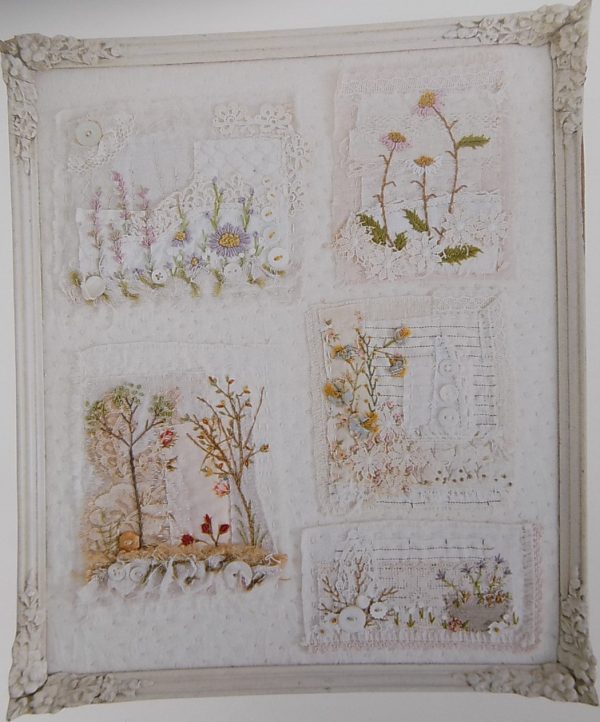
The Gallery section offers readers delightful projects for embellishment – teddy bears, purses and bags, cushions and quilts. This book would make an ideal gift for anyone interested in arts and crafts. For children learning embroidery at school and adults who want a new hobby. Textile artists (such as myself) can use the extensive library of stitches within their own work. A versatile and expressive addition to any craft library.

Anything wrong with the book?
No! You have a wealth of information to make use of whatever you can find at home or in flea markets and charity shops, making projects inexpensive. Recycling is the foundation of my own textile work, creating beauty from existing clothes and soft furnishings. If you need to buy embroidery threads you can do so on a budget because flower embroideries are small scale and threads will go a long way. With such a range of stitch available beginners can start with the basics and evolve to more complex variations. Embroidery is a beautiful and effective way in which to embellish and can be learned in a short time because of it’s repetitive nature. To create your own miniature textile garden is a wonderful addition to any home and would make a unique gift to be treasured for years.
Conclusion
Get your copy using this link – Foolproof Flower Embroidery – and support local bookshops!



